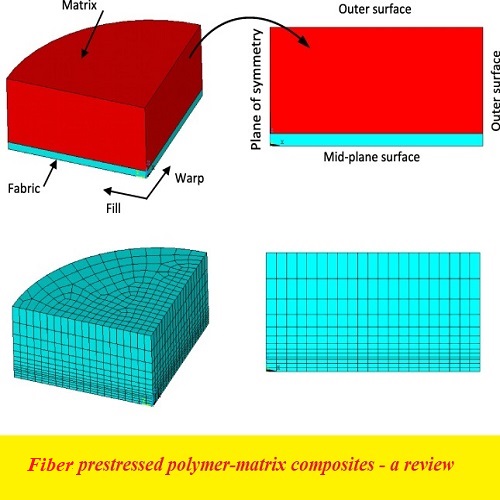Admin
مدير المنتدى


عدد المساهمات : 18996
التقييم : 35494
تاريخ التسجيل : 01/07/2009
الدولة : مصر
العمل : مدير منتدى هندسة الإنتاج والتصميم الميكانيكى
 |  موضوع: بحث بعنوان Fiber prestressed polymer-matrix composites - a review موضوع: بحث بعنوان Fiber prestressed polymer-matrix composites - a review  الجمعة 05 فبراير 2021, 1:03 am الجمعة 05 فبراير 2021, 1:03 am | |
| 
أخوانى فى الله
أحضرت لكم كتاب
بحث بعنوان
Fiber prestressed polymer-matrix composites - a review
Nawras H Mostafa1,2, ZN Ismarrubie2, SM Sapuan2,3 and
MTH Sultan4

و المحتوى كما يلي :
Abstract
This article reviews the literature studies based on improving the mechanical properties of fibre-reinforced composites
using fibre-prestressing method. The idea is characterized by pretensioning the fibres either elastically or viscoelastically
prior matrix curing. The beginnings of the studies in this field were focused on reducing fibre waviness and breaking the
weaker fibres by pretensioning the fibres to a relatively high stress level prior moulding process. In the last three decades,
the concept of fibre prestressing had been developed to include its ability to reduce the effect of undesired residual
stresses existence accompanying manufacturing process of fibre-reinforced composites. The main advantage of fibre
prestressing method is to generate a desired and controlled residual stress state within the matrix in order to obstruct
the initiation and propagation of cracks. Various techniques of fibre prestressing have been reviewed to show their scope
of applications, developments and limitations. Therefore, the findings drawn from this review can be used for further
studies in the field of fibre prestressed composites in order to select the most suitable methodology and develop it to fit
the manufacturing process requirements towards a production of high-performance composites without a considerable
additional cost.
Keywords
Fibre pretension, polymeric matrix composites, prestressing method, microcracks, residual stresses
Conclusions
This review article attempted to cover most studies
related to fibre prestressing method and its developments. Initially, the fibre pretension method was used
to decrease the fibre waviness and then after to detect
and break the weak fibres before moulding it into the
resin. Therefore, the structural properties of the final
product were enhanced by eliminating the negative
effect of weak fibre’s existence. Subsequently, the idea
of the fibre pretension was extended to include its benefits for obstructing the matrix cracking and its development. The focus was related directly to minimize the
generated residual stresses during fabrication processes.
The existence of tensile residual stress affects the composite structural performance directly and becomes
more detrimental when the composites are subjected
to external loading than the unloaded ones during service life.
The interest in the subject began since 1968, which
included structural properties like tensile modulus,
tensile strength, flexural modulus, flexural strength,
compressive modulus, compressive strength, fatigue
and impact toughness. The overall effects of fibre
pre-stressing on these structural properties were positive. Several mechanisms were attributed to enhance the
PMC’s structural properties. These mechanisms are (i)
generating compressive residual stresses within the
matrix upon releasing the fibre pretension and this
makes the matrix more resistant to cracks initiation
and propagation, (ii) improving the architecture of
the yarns to become straighter and tighter, thereby
the load is instantaneously transferred from matrix to
the fibre, (iii) breaking the weaker fibres prior moulding
process, (iv) adapting the composite to absorb more
impact energy by increasing the fibre-matrix debonding
damage and (v) creating a transverse force opposite to
bending load. For various composite systems used in
the previous studies, a maximum increase in the structural properties was recorded to range up to 10–60%
(tensile modulus) and 15–140% (tensile strength), 10–
50% (flexural modulus) and 10–67% (flexural
strength), 9% (compressive strength), 25–62%
(impact strength) and 43–200% (fatigue life).
Although fibre prestressing can significantly improve
structural properties, there are potential disadvantages.
In case of EFPPMCs type, the main disadvantages or
restrictions are its complexity to apply for non-flat constructions, the applied prestress value is a function of
plies number that formed the composite
كلمة سر فك الضغط : books-world.net
The Unzip Password : books-world.net
أتمنى أن تستفيدوا من محتوى الموضوع وأن ينال إعجابكم
رابط من موقع عالم الكتب لتنزيل بحث بعنوان Fiber prestressed polymer-matrix composites - a review
رابط مباشر لتنزيل بحث بعنوان Fiber prestressed polymer-matrix composites - a review 
|
|







